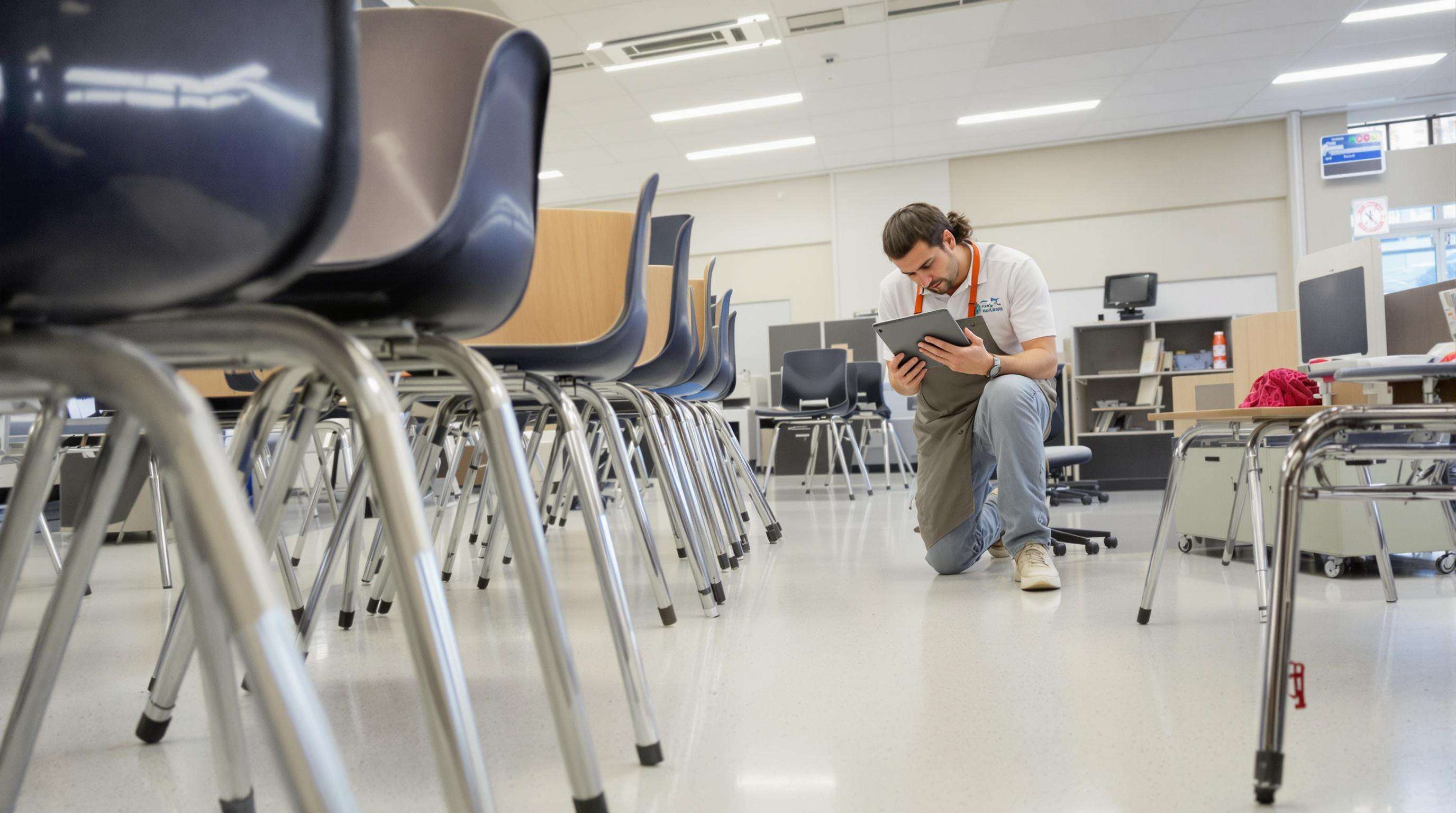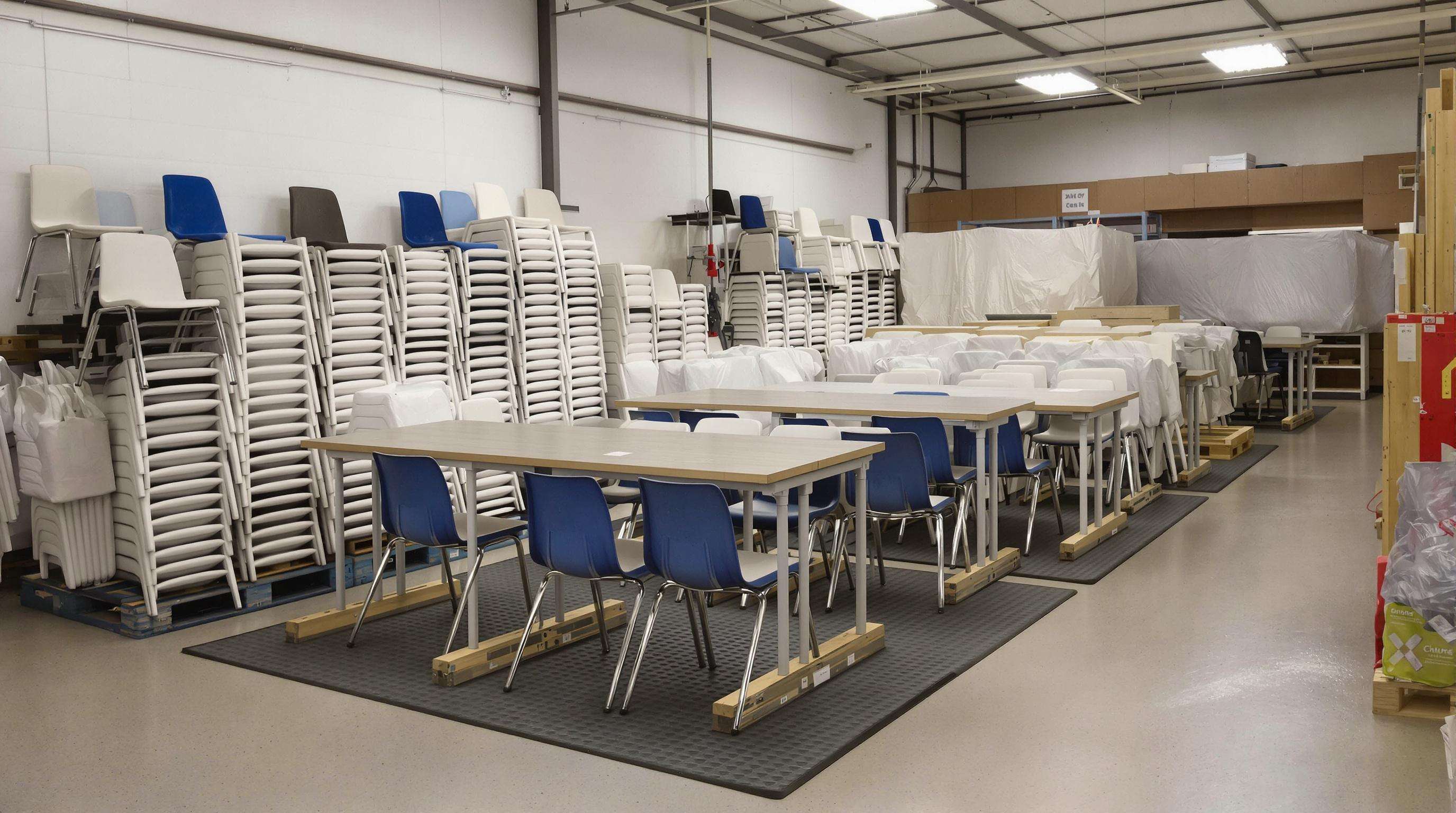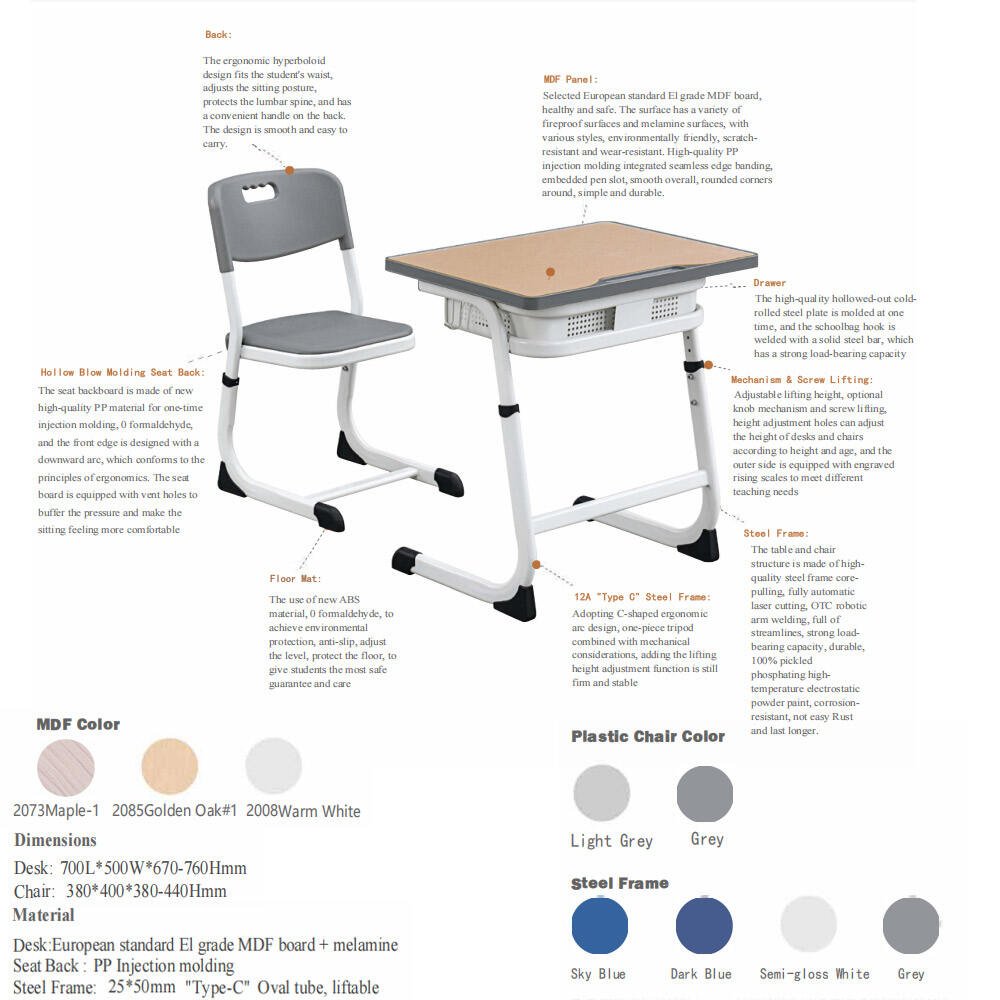การเข้าใจกลยุทธ์ในการบำรุงรักษาเฟอร์นิเจอร์ในห้องเรียน
การบำรุงรักษาเฟอร์นิเจอร์ของโรงเรียนในห้องเรียนอย่างมีประสิทธิภาพจำเป็นต้องมีแนวทางที่เป็นระบบ โดยรวมถึงการดูแลเชิงรุกและการจัดสรรทรัพยากรอย่างมีกลยุทธ์ สถาบันการศึกษาที่ใช้โปรแกรมการบำรุงรักษาแบบเป็นระบบรายงานว่าเฟอร์นิเจอร์มีอายุการใช้งานยาวนานขึ้นถึง 23% เมื่อเทียบกับการใช้รูปแบบการบำรุงรักษาแบบแก้ปัญหา (Education Facilities Clearinghouse 2022)
องค์ประกอบหลักของการวางแผนบำรุงรักษาอย่างมีประสิทธิภาพ
สามเสาหลักที่สนับสนุนโปรแกรมการบำรุงรักษาที่ประสบความสำเร็จ:
- การตรวจสอบตามกำหนด : การตรวจสอบเป็นประจำทุกสัปดาห์ของข้อต่อเก้าอี้ พื้นผิวโต๊ะ และบานพับตู้เก็บของ
- การฝึกอบรมบุคลากร : การจัดเวิร์กช็อปประจำปีเกี่ยวกับการระบุตัวยึดหลวมและโครงสร้างที่เสื่อมสภาพ
- ระบบการบันทึกข้อมูล : บันทึกข้อมูลดิจิทัลที่ติดตามประวัติการซ่อมแซมและรอบการเปลี่ยนชิ้นส่วน
การเปลี่ยนผ่านไปสู่การบำรุงรักษาเชิงป้องกันในสถาบันการศึกษา
เขตโรงเรียนต่างๆ เริ่มหันมาใช้รูปแบบการบำรุงรักษาเชิงป้องกันมากขึ้น หลังรายงานสภาพพื้นที่การศึกษาแห่งชาติปี 2022 แสดงให้เห็นว่าแนวทางนี้สามารถลดค่าใช้จ่ายในการเปลี่ยนทดแทนประจำปีลงได้ถึง 40% กลยุทธ์นี้ให้ความสำคัญกับ:
- การประเมินสภาพเฟอร์นิเจอร์ก่อนเปิดภาคเรียน
- การซ่อมแซมโครงสร้างเก้าอี้นักเรียนที่มีลักษณะโยกคลอนทันที
- การเคลือบสารป้องกันพื้นผิวที่ใช้งานหนัก
กรณีศึกษา: การบำรุงรักษาอย่างมีวินัยในเขตโรงเรียนเมือง
เขตเมืองขนาดกลางแห่งหนึ่งสามารถยืดอายุการใช้งานโต๊ะและเก้าอี้นักเรียนได้เพิ่มขึ้นอีก 5 ปี ด้วยการดำเนินการดังต่อไปนี้:
- การทำความสะอาดลึกทุก 6 เดือน ของพื้นที่ทุกส่วนในห้องเรียน
- การอัปเกรดวัสดุที่ทนทานต่อการก่อความเสียหาย สำหรับโต๊ะในพื้นที่ส่วนกลาง
- ทีมตรวจสอบที่นำโดยนักเรียน การบันทึกสภาพการสึกหรอ
วิธีการนี้ช่วยลดค่าใช้จ่ายในการเปลี่ยนเฟอร์นิเจอร์ลง 18 ดอลลาร์ต่อนักเรียนต่อปี ในขณะที่ปรับปรุงคะแนนการตรวจสอบความปลอดภัยในห้องเรียนให้สูงขึ้น 34% ภายในระยะเวลาสามปีการศึกษา
การตรวจสอบเป็นประจำและการตรวจจับความเสียหายแต่เนิ่นๆ สำหรับเฟอร์นิเจอร์โรงเรียนในห้องเรียน

รายการตรวจสอบประจำวันและประจำสัปดาห์สำหรับเก้าอี้ โต๊ะ และหน่วยจัดเก็บ
การดำเนินการตรวจสอบอย่างเป็นระบบจะช่วยให้เฟอร์นิเจอร์โรงเรียนในห้องเรียนยังคงมีสภาพการใช้งานที่ดีและปลอดภัย รายการตรวจสอบประจำวันควรประกอบด้วย:
- การตรวจสอบพื้นผิว : ตรวจสอบคราบหกเลอะ รอยขีดข่วน หรือภาพวาดบนกำแพง
- การตรวจสอบชิ้นส่วนต่างๆ : ขันสกรู น็อต หรือบานพับที่หลวม
- ความสมบูรณ์ของโครงสร้าง : ทดสอบความมั่นคงของขาเก้าอี้และโต๊ะ
- การตรวจสอบความคล่องตัว : ตรวจสอบล้อของหน่วยจัดเก็บให้หมุนได้อย่างอิสระ
ระเบียบวิธีรายสัปดาห์จะต้องดำเนินการประเมินเชิงลึก:
- ตรวจสอบข้อต่อของเฟอร์นิเจอร์ว่ามีรอยแยกหรือรอยแตกร้าวหรือไม่
- ตรวจสอบพื้นผิวที่เคลือบแลมิเนตว่ามีรอยลอกที่ขอบหรือไม่
- ตรวจสอบป้ายแสดงน้ำหนักที่รองรับได้บนตู้จัดเก็บ
- จดบันทึกผลโดยใช้เครื่องมือรายงานมาตรฐาน
โรงเรียนที่ให้ความสำคัญกับระบบดังกล่าวสามารถลดค่าใช้จ่ายในการซ่อมแซมลงได้ 30% เมื่อเทียบกับการดำเนินการแบบแก้ปัญหาหลังเกิดเหตุ (รายงานสถานที่สำนักงานการศึกษา ปี 2023)
การตรวจจับสัญญาณการสึกหรอ ความเสียหายจากวัยร้าย และความเสียหายโครงสร้างในระยะเริ่มต้น
การตรวจจับอย่างเชิงรุกจะช่วยป้องกันปัญหาเล็กน้อยไม่ให้กลายเป็นอันตรายต่อความปลอดภัย:
| ประเภทวัสดุ | สัญญาณเตือนที่พบบ่อย | ลำดับความสำคัญในการแก้ไข |
|---|---|---|
| ไม้ | ขอบแตกเป็นเสี้ยน โครงสร้างบิดงอ | ขัดทราย/ปิดผิวใหม่ทันที |
| โลหะ | คราบสนิม โครงสร้างบิดงอ | การป้องกันการกัดกร่อน |
| พลาสติก | รอยร้าว สีซีดจาง | แนะนำให้เปลี่ยนใหม่ |
สังเกตพฤติกรรมทำลายข้าวของตามลักษณะเหล่านี้:
- การขีดข่วนที่กระจุกตัวอยู่ที่ขอบโต๊ะ
- คราบหมึกจากปากกาแมร์เกอร์ใกล้กับเต้าเสียบไฟฟ้า
- กลไกล็อกลิ้นชักที่ถูกดัดแปลง
สัญญาณเตือนโครงสร้างรวมถึง:
- เก้าอี้แกว่งโดยไม่มีแรงกด
- พื้นโต๊ะเอียงมากกว่า 5° จากแนวระดับ
- ประตูตู้ไม่สามารถล็อกได้อย่างมั่นคง
การฝึกอบรมเจ้าหน้าที่ให้สามารถสังเกตสัญญาณเตือนเหล่านี้ระหว่างการตรวจตราตามปกติ จะช่วยให้โรงเรียนสามารถแก้ไขปัญหาได้ถึง 85% ก่อนที่จะส่งผลกระทบต่อการใช้งาน
การทำความสะอาดและการดูแลรักษาเฉพาะวัสดุของเก้าอี้และโต๊ะในห้องเรียน
แนวทางปฏิบัติที่ดีที่สุดสำหรับการทำความสะอาดเฟอร์นิเจอร์สำนักงานโรงเรียนที่ใช้งานหนักในห้องเรียน
การทำความสะอาดเป็นประจำจะช่วยป้องกันไม่ให้เชื้อโรคสะสม และทำให้สิ่งต่าง ๆ ดูดีอยู่เสมอ ให้ใช้ผ้าไมโครไฟเบอร์และสบู่อ่อน ๆ สำหรับเช็ดเก้าอี้ โต๊ะ และตู้เก็บของ วิธีนี้จะช่วยกำจัดคราบสกปรกและคราบไขมันส่วนใหญ่ได้โดยไม่ทำให้พื้นผิวถูกขูดขีด อย่างไรก็ตาม ควรหลีกเลี่ยงการใช้แผ่นขัดหยาบหรือสารเคมีที่มีความเข้มข้นสูง เพราะอาจทำให้ผิวเคลือบลามิเนตและพลาสติกเสื่อมสภาพลงเมื่อใช้ไปเรื่อย ๆ โต๊ะในห้องปฏิบัติการวิทยาศาสตร์ที่ได้รับการดูแลตลอดเวลา จำเป็นต้องล้างน้ำให้สะอาดอีกครั้งหลังจากล้างเสร็จ เพื่อชะล้างคราบสบู่ที่เหลืออยู่ ทีมงานบำรุงรักษาสถานที่ของปี 2024 พบว่า ขั้นตอนง่าย ๆ นี้สามารถทำให้วัสดุใช้งานได้นานขึ้นประมาณ 40 เปอร์เซ็นต์ ควรตรวจสอบเสมอว่าทุกอย่างแห้งสนิทก่อนที่เด็ก ๆ จะเข้ามาใช้งานอีกครั้ง มิฉะนั้นจุดที่ยังเปียกอยู่อาจทำให้ไม้บิดงอหรือเกิดเชื้อราในช่วงระหว่างคาบเรียน
การเลือกผลิตภัณฑ์ทำความสะอาดที่เหมาะสมสำหรับวัสดุเฟอร์นิเจอร์ที่แตกต่างกัน
| วัสดุ | สารทำความสะอาดที่แนะนำ | หลีกเลี่ยง |
|---|---|---|
| ลามิเนตลดแรงดันสูง | สารซักฟอกที่มีค่า pH เป็นกลาง, แอลกอฮอล์ไอโซโพรพิล | น้ำยาฟอกขาว, ผลิตภัณฑ์ที่มีส่วนผสมของแอมโมเนีย |
| โลหะเคลือบผง (Powder-coated metal) | สบู่อ่อน, สารละลายผสมน้ำส้มสายชูและน้ำ | สารทำความสะอาดที่มีความเป็นกรด, แผ่นขัดเหล็ก |
| ไม้แข็ง | ขี้ผึ้งบีสแว็กซ์ ผ้าชุบน้ำหมาด | น้ำส่วนเกิน สเปรย์ซิลิโคน |
| ผ้าบุเบาะ | ตัวทำละลายคราบโปรตีนจากเอนไซม์ | สารทำละลาย น้ำร้อน |
การดูแลรักษาเฟอร์นิเจอร์ไม้และเบาะผ้าบุให้อยู่ในสภาพดีโดยไม่เกิดความเสียหาย
เฟอร์นิเจอร์ไม้ในห้องเรียนจำเป็นต้องได้รับการดูแลเป็นประจำหากต้องการให้ใช้งานได้ยาวนานขึ้น การทาแว็กซ์ป้องกันทุกสามเดือนจะช่วยลดรอยขีดข่วนที่น่ารำคาญและป้องกันไม่ให้ความชื้นซึมเข้าไปในลายไม้ เราขอแนะนำให้ใช้แผ่นรองสักหลาดรองขาเก้าอี้เพื่อไม่ให้ทิ้งรอยเปื้อนไปทั่วพื้น เมื่อต้องจัดการกับเบาะนั่งที่บุด้วยผ้า ให้รีบจัดการทันทีเมื่อมีคราบหกเลอะเทอะ หยิบผ้าไมโครไฟเบอร์ขึ้นมาซับเบาๆ สำหรับคราบฝังแน่น น้ำยาทำความสะอาดสูตรเอนไซม์จะช่วยขจัดคราบต่างๆ เช่น คราบอาหาร โดยไม่ทำให้สีซีดจางหรือทำลายเนื้อผ้า อย่าลืมหมุนเบาะนั่งเดือนละครั้งด้วย นิสัยง่ายๆ นี้จะช่วยกระจายคราบที่สึกหรอไปยังจุดต่างๆ ซึ่งหมายความว่าโดยรวมแล้วต้องเปลี่ยนเบาะบ่อยน้อยลง โรงเรียนที่ปฏิบัติตามเคล็ดลับการบำรุงรักษาขั้นพื้นฐานเหล่านี้มักจะประหยัดเงินได้ประมาณ 3,000 ดอลลาร์ต่อปีจากการเปลี่ยนเฟอร์นิเจอร์เพียงอย่างเดียว
การบำรุงรักษาตามฤดูกาล การจัดเก็บ และกลยุทธ์เพื่อความทนทานในระยะยาว

การจัดทำแผนบำรุงรักษาเฟอร์นิเจอร์ในห้องเรียนตามฤดูกาล
การกำหนดงานบำรุงรักษาให้สอดคล้องกับปฏิทินการศึกษา จะช่วยให้การเรียนการสอนไม่ถูกรบกวนมาก School ที่ตรวจสอบเฟอร์นิเจอร์ในห้องเรียนทุกไตรมาส โดยเฉพาะก่อนช่วงปิดภาคเรียนฤดูร้อนและช่วงวันหยุดฤดูหนาว จะสามารถแก้ไขปัญหาโครงสร้างได้ถึง 63% ก่อนที่ปัญหาจะทวีความรุนแรงขึ้น (วารสารสิ่งอำนวยความสะดวกทางการศึกษา ปี 2023) แนวทางที่มีประสิทธิภาพคือการดำเนินการใน 3 ขั้นตอนดังนี้:
- ฤดูใบไม้ผลิ : ขันสกรูที่หลวม ซ่อมขาเก้าอี้ที่โย้ และตรวจสอบพื้นโต๊ะว่ามีรอยขีดข่วนหรือไม่
- ฤดูร้อน : ทำความสะอาดพื้นผิวอย่างล้ำลึก ปรับปรุงพื้นไม้ที่สึก และเปลี่ยนเบาะเก้าอี้ที่เสียหาย
- ฤดูหนาว : ตรวจสอบหน่วยเก็บข้อมูลเพื่อดูความเสียหายจากความชื้น และใส่น้ำมันหล่อลื่นในบานพับโลหะ
การจัดการและการจัดเก็บเฟอร์นิเจอร์อย่างเหมาะสมในช่วงปิดภาคเรียน
อายุการใช้งานของเฟอร์นิเจอร์จะลดลงถึง 34% หากจัดเก็บอย่างไม่เหมาะสมในช่วงปิดภาคเรียนยาว ควรปฏิบัติดังนี้เสมอ:
- ทำความสะอาดพื้นผิวให้ละเอียดเพื่อป้องกันเชื้อราและคราบเปื้อน
- วางเก้าอี้ซ้อนกันในแนวตั้งบนแผ่นรองยางเพื่อป้องกันการบิดงอ
- คลุมโต๊ะด้วยผ้าที่ระบายอากาศได้ดีแทนการใช้พลาสติก เพื่อลดการเกิดน้ำควบแน่น
พื้นที่จัดเก็บที่ควบคุมสภาพอากาศเป็นทางเลือกที่ดีที่สุดแต่ไม่ใช่สิ่งจำเป็น—การยกเฟอร์นิเจอร์ให้สูงกว่าพื้นคอนกรีต 6 นิ้ว ช่วยป้องกันความเสียหายจากความชื้นได้ถึง 89% ในห้องจัดเก็บมาตรฐาน
การยืดอายุการใช้งาน: ซ่อมแซมหรือเปลี่ยนใหม่ และการป้องกันการใช้งานหนักเกินไป
การวิเคราะห์ในปี 2023 ของงานซ่อมแซมห้องเรียน 12,000 ชิ้น พบว่าค่าใช้จ่ายในการซ่อมแซมโต๊ะเรียนมีราคาถูกกว่าการเปลี่ยนใหม่ถึง 78% ควรให้ความสำคัญกับการซ่อมแซมในกรณีดังต่อไปนี้:
- วัสดุคอมโพสิตที่แกนโครงสร้างยังสมบูรณ์
- เก้าอี้ที่ต้องการการเชื่อมหรือหุ้มเบาะใหม่เพียงเล็กน้อย
ควรเปลี่ยนใหม่เมื่อ: - โต๊ะไม้อัดพบความเสียหายจากน้ำลึกกว่าชั้นผิวหนัง
- โครงเก้าอี้มีรอยร้าวจากแรงดันใกล้จุดเชื่อม
การหมุนเวียนการใช้งานเฟอร์นิเจอร์ระหว่างห้องเรียนช่วยลดการสึกหรอที่กระจุกตัวได้ 41% โดยเฉพาะในพื้นที่ที่มีการสัญจรไปมาสูง เช่น ห้องสมุดและโรงอาหาร
ความปลอดภัย การประหยัดค่าใช้จ่าย และผลกระทบต่อสภาพแวดล้อมการเรียนรู้จากเฟอร์นิเจอร์ที่ได้รับการบำรุงรักษาอย่างดี
การบำรุงรักษาเฟอร์นิเจอร์ในห้องเรียนอย่างสม่ำเสมอเพื่อความปลอดภัยของนักเรียน
การรักษารูปลักษณ์ของเฟอร์นิเจอร์ในโรงเรียนให้อยู่ในสภาพที่ดีนั้นมีความสำคัญอย่างมากต่อความปลอดภัยของนักเรียน เนื่องจากสามารถตรวจจับปัญหาได้ตั้งแต่แรกเริ่ม เช่น ขาเก้าอี้โยก เค้าเตอร์โต๊ะมีส่วนที่ขรุขระ หรือโต๊ะที่อาจล้มคว่ำหากไม่ได้รับการซ่อมแซม ในปี 2022 มีบางโรงเรียนได้ทำการตรวจสอบทั่วทั้งเขตและพบสิ่งที่น่าสนใจว่า โรงเรียนที่ดำเนินการตรวจสอบเป็นประจำทุกเดือนนั้นมีจำนวนผู้บาดเจ็บที่เกี่ยวข้องกับเฟอร์นิเจอร์ลดลงมากถึงประมาณ 62% เมื่อเทียบกับโรงเรียนที่รอจนกว่าจะเกิดปัญหาขึ้นจริง งานง่ายๆ ก็มีความสำคัญอย่างมากเช่นกัน ครูสามารถขันสกรูที่หลวมบนเก้าอี้ ยึดโครงสร้างโต๊ะที่เริ่มอ่อนแอ และเปลี่ยนชิ้นส่วนพลาสติกที่เริ่มแตกร้าวก่อนที่นักเรียนจะได้รับบาดเจ็บระหว่างทำงานในชั้นเรียนหรือทำงานกลุ่ม
การบำรุงรักษาช่วยลดค่าใช้จ่ายในระยะยาวของสถาบันการศึกษา
การดูแลเชิงรุกช่วยยืดอายุการใช้งานเฟอร์นิเจอร์ได้เฉลี่ย 8–12 ปี และลดงบประมาณในการเปลี่ยนทดแทนลง 40% ต่อปี การทำสีใหม่โต๊ะไม้ทุก 3 ปีแทนที่จะซื้อใหม่ ช่วยประหยัดได้ 120–180 ดอลลาร์ต่อชิ้น โรงเรียนที่นำระบบการบำรุงรักษาตามฤดูกาลมาใช้ มีค่าซ่อมแซมฉุกเฉินลดลง 73% ทำให้เขตพื้นที่สามารถจัดสรรเงินทุนใหม่เพื่อสนับสนุนเครื่องมือการศึกษาได้
บทบาทของเฟอร์นิเจอร์ที่มีความทนทานในการเสริมสร้างประสบการณ์การเรียนรู้ของนักเรียน
เมื่อห้องเรียนมีเฟอร์นิเจอร์ที่แข็งแรงและได้รับการบำรุงรักษาอย่างเหมาะสม แท้จริงแล้วจะช่วยให้เด็กๆ มีสมาธิในการเรียนรู้ได้ดีขึ้น เนื่องจากพวกเขาจะไม่ถูกรบกวนด้วยเก้าอี้โยกหรือโต๊ะที่เอียงไปด้านใดด้านหนึ่ง นอกจากนี้ มีการศึกษาล่าสุดบางส่วนยังค้นพบสิ่งที่น่าสนใจเพิ่มเติมอีกด้วย นั่นคือ นักเรียนที่นั่งเรียนในห้องที่มีเฟอร์นิเจอร์คุณภาพดีและไม่ชำรุด มักจะทำคะแนนสอบมาตรฐานได้ดีกว่าผู้ที่ต้องเรียนในพื้นที่สภาพแย่ลงประมาณ 11 เปอร์เซ็นต์ และอย่าลืมถึงเรื่องท่าทางการนั่งด้วย เฟอร์นิเจอร์โต๊ะและเก้าอี้ที่มีความมั่นคงช่วยส่งเสริมท่าทางการนั่งที่ดีขึ้น ซึ่งส่งผลที่ชัดเจนมาก ครูผู้สอนรายงานว่า นักเรียนมีอาการปวดหลังลดลงประมาณ 34% เมื่อต้องศึกษาเป็นเวลานานในสภาพแวดล้อมที่นั่งเรียนมีเสถียรภาพเช่นนี้
ส่วน FAQ
องค์ประกอบหลักของแผนการบำรุงรักษาเฟอร์นิเจอร์ในห้องเรียนที่มีประสิทธิภาพคืออะไร?
องค์ประกอบหลัก ได้แก่ การตรวจเช็กตามกำหนดเวลา ช่วงการฝึกอบรมเจ้าหน้าที่ และระบบจัดเก็บข้อมูลที่สามารถติดตามประวัติการซ่อมแซมและรอบการเปลี่ยนทดแทนได้
เฟอร์นิเจอร์ในห้องเรียนควรได้รับการตรวจเช็กบ่อยแค่ไหน?
ควรตรวจสอบสภาพเฟอร์นิเจอร์ทุกสัปดาห์เพื่อตรวจหาปัญหาเล็กน้อย และตรวจสอบอย่างละเอียดทุกไตรมาส โดยเฉพาะก่อนช่วงวันหยุดฤดูร้อนและฤดูหนาว
ทำไมการบำรุงรักษาเชิงป้องกันจึงได้รับความนิยมมากกว่าการบำรุงรักษาแบบแก้ปัญหา?
การบำรุงรักษาเชิงป้องกันช่วยลดค่าใช้จ่ายในการเปลี่ยนเฟอร์นิเจอร์ประจำปีลงได้ 40% และยืดอายุการใช้งานของเฟอร์นิเจอร์ให้นานขึ้น 23% เมื่อเทียบกับการบำรุงรักษาแบบแก้ปัญหา
โรงเรียนจะสามารถจัดเก็บเฟอร์นิเจอร์ให้ถูกต้องในช่วงวันหยุดได้อย่างไร?
โรงเรียนควรทำความสะอาดพื้นผิวให้ละเอียด เก็บเก้าอี้โดยวางซ้อนกันบนแผ่นรองยางเพื่อป้องกันการบิดงอ และคลุมโต๊ะด้วยผ้าที่ระบายอากาศได้ดีเพื่อลดการเกิดน้ำควบแน่น โดยอุดมคติแล้ว เฟอร์นิเจอร์ควรถูกยกให้สูงกว่าพื้นปูน 6 นิ้ว เพื่อป้องกันความเสียหายจากความชื้น
สารบัญ
- การเข้าใจกลยุทธ์ในการบำรุงรักษาเฟอร์นิเจอร์ในห้องเรียน
- การตรวจสอบเป็นประจำและการตรวจจับความเสียหายแต่เนิ่นๆ สำหรับเฟอร์นิเจอร์โรงเรียนในห้องเรียน
- การทำความสะอาดและการดูแลรักษาเฉพาะวัสดุของเก้าอี้และโต๊ะในห้องเรียน
- การบำรุงรักษาตามฤดูกาล การจัดเก็บ และกลยุทธ์เพื่อความทนทานในระยะยาว
- ความปลอดภัย การประหยัดค่าใช้จ่าย และผลกระทบต่อสภาพแวดล้อมการเรียนรู้จากเฟอร์นิเจอร์ที่ได้รับการบำรุงรักษาอย่างดี
- ส่วน FAQ


